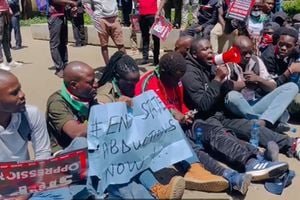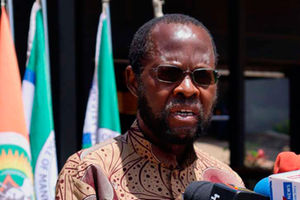New Koitalel mausoleum focal point 116 years since his assassination
The front view of Koitalel arap Samoei mausoleum in Nandi-Hills town, Nandi County.
The construction of the multimillion-shilling Koitalel Samoei mausoleum and museum equipped with Nandi artefacts has become a centre of attraction among scholars of cultural studies.
It is drawing local and international researchers interested in the Nandi uprising against British colonial rule and the ensuing killing of legendary Nandi leader Koitalel Samoei on October 19, 1905 by Col Richard Meinertzhagen after seven years of resistance.
“The construction of the mausoleum and museum is a major boost to scholars from far and wide who want to know more about the Nandi resistance and culture,” said curator Francis K. Talam.
The shield-shaped mausoleum, signifying the traditional ‘bulletproof’ shield used by warriors during the Nandi resistance, serves as the statue of Koitalel with the symbol of a lion associated with the Talai clan, he said.
Sandwiched between the four pillars will be the Koitalel traditional pot with the brew used during the foretelling of the coming of colonialists.
“Once complete and fully operational, the mausoleum will also have a metallic snake-like pillar, indicating the railway line that Koitalel predicted before the Nandi resistance,” Mr Talam disclosed.
He said the mausoleum will also be fitted with a computer containing information on Kalenjin history, making it easier for visitors to access it.
Historians and other scholars
The museum, built on almost one acre on the Nandi Hills-Kaptumo highway, is equipped with Nandi cultural artefacts, making it a centre of attraction for historians and other scholars.
“We have collections of almost all Kalenjin artefacts and historical background,” said Mr Talam, adding that preparations were underway for the 116th anniversary of Koitalel’s assassination.
The annual celebration – held every October 19 - will take place at Nandi Bears Club, less than one kilometre from the museum.
Adjacent to the mausoleum are two traditional grass-thatched huts (kot ab gaa), complete with Kalenjin regalia and cultural names bearing specific meanings in harmony with events organised by the local community.
Standing tall in the compound are two huge fig trees, one believed to have grown where Koitalel was buried more than a century ago.
The catacomb has two doors, with the main entrance facing north- west towards Mt Elgon from Nandi Hills, believed to be the entry point of members of the Kalenjin community into what is now Kenya during the migration period.
Shot dead
The rear door, which faces south, is slightly shorter and a visitor must squat to enter.
It is used mainly for ceremonial activities, especially during the initiation of boys.
The inner roof of the mausoleum is supported by four tall pillars, just like the Kalenjin traditional stool used by respectable elders in the community. It signifies stability and unity among community members.
On the eastern side of the catacomb is Koitalel’s symbolic grave, artistically designed with marble to exhibit that there is a missing head.
“Koitalel Samoei arap Turgat Mausoleum was laid by President Mwai Kibaki on December 19, 2007,” says a plaque on the building.
Elders say that after seven years of resistance, Koitalel and his ministers and messengers were killed by British soldiers led by Col Richard Meinertzhagen.
“I’ve been called by the white man for a truce but my spirits tell me he is not sincere,” foretold the Orkoiyot.
And true to his prediction, the ‘handshake’ turned into betrayal and Koitalel and his team were all shot dead, but that act later troubled Col Meinertzhagen.
“My drastic action on this occasion haunted me for many years. I Richard Meinertzhagen murdered Koitalel Samoei, the Nandi Orkoiyot on the 19th October 1905,” said Col Meinertzhagen in his confessions.
Nandi elders termed the killing an act of betrayal by British colonialists, who went ahead to commit more atrocities against the community.
Local community
“Koitalel Samoei was shot dead in October 1905 at Ketbarak near the sporting facility after leading a rebellion against British colonialists. The community suffered a lot and is yet to receive justice,” Nandi elder Samuel Ng’etich said in an interview.
Next to the Koitalel museum is the scenic Nandi Bears Club, referred to as the Ketbarak by the local community.
The Nandi bear (locally referred to as kerit) is a mysterious beast believed to have lived near the current Nandi Bears Club many years ago before it became extinct.
“This was the meeting point for members of the Nandi community to receive blessings from their spiritual elders and plan their future before Koitalel was killed together with his messengers,” explained Mr Ng’etich.
The colonialists chopped off Koitalel’s head after killing him and took it and other items to London.
The skull is believed to be in the Pitts Rivers Museum in London among other African artefacts.
A documentary by scholars indicates that more than 1,000 Kenyan artifacts are in the British Museum, Royal Museum and Pitts River Museum.
In one corner of the four-room museum is Koitalel’s royal batons inside transparent glass.
“These treasured staffs of office of Orgoiyot Koitalel Samoei were recovered through the diligent efforts and guidance of Egyptologist Dr Kipkoech arap Sambu and doctoral student Kipnyango arap Seroney with the cooperation of Col Richard Meinertzhagen’s son Randle Meinertzhagen on 23rd of January 2006,” states a plague on the safe where the batons are kept.




